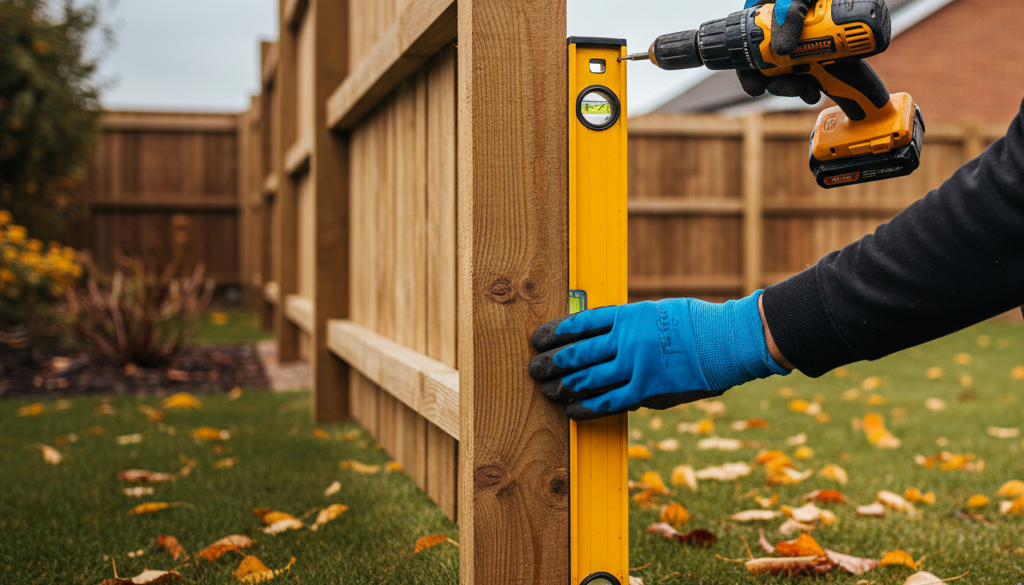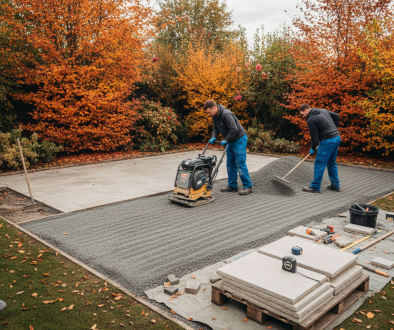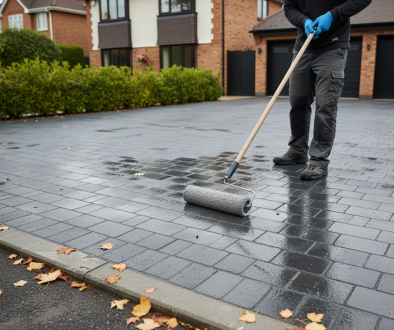Fence Problems to Spot Before Winter Storms
Autumn is the season to take a closer look at your garden fencing. As wind, rain, and frost become more frequent, even a small weakness can quickly turn into costly damage. Broken panels, leaning posts, or rusted fittings might seem minor now—but during a winter storm, they can collapse or cause safety hazards.
Taking time to inspect and repair your fence in autumn ensures your property stays secure, your garden protected, and your home looking tidy throughout the colder months. Here’s what to watch for and how to strengthen your fencing before winter sets in.
Leaning or Unstable Posts
Fence posts form the backbone of every structure. If they’re loose or leaning, the entire fence becomes vulnerable to strong winds. A quick visual check can reveal early warning signs such as uneven lines, wobbling sections, or shifting soil around the base.
Wooden posts often deteriorate where they meet the ground, as moisture collects and accelerates rot. Concrete or metal posts, while more durable, can loosen if their foundations crack or if water freezes and expands in small gaps. The solution depends on the material: wooden posts may need replacing, while concrete-set posts can often be stabilised with fresh ballast or post mix.
Ensuring posts are properly aligned and deeply anchored prevents movement during high winds. Strengthening this foundation now can save the expense of full fence replacement later.

Rotting or Cracked Timber Panels
Timber fencing offers natural beauty, but it’s also highly susceptible to moisture damage. When untreated wood absorbs rainwater, it expands and contracts as temperatures change. Over time, this leads to cracks, warping, and decay.
Examine panels closely for soft spots, dark staining, or splintering—these are signs of internal rot. Replacing damaged boards before winter prevents the issue from spreading. Once repairs are complete, apply a weatherproof wood preservative or sealant to block moisture absorption.
Modern fence treatments with UV protection also help retain colour and prevent premature greying. Investing a few hours in sealing now can extend your fence’s lifespan by several years.
Loose or Rusted Fittings
Screws, nails, hinges, and brackets often go unnoticed until they fail. Metal components expand and contract with temperature shifts, gradually loosening or corroding. Rust weakens their grip and can stain nearby timber, leaving unsightly marks.
Walk along your fence and test gates, latches, and fastenings for movement. Replace any rusted or bent hardware, and tighten all joints using galvanised or stainless steel fittings that resist corrosion. For older fences, consider switching to exterior-grade fixings with protective coatings.
Maintaining these small connections prevents panels from rattling in the wind and ensures your fence stays structurally sound when storms arrive.
Damaged Gravel Boards and Base Rot
Gravel boards sit between the fence panels and the ground, shielding the wood from constant soil contact. When these boards deteriorate, moisture can wick upward, accelerating rot in the lowest panels.
Check whether gravel boards are cracked, bowed, or shifting away from their supports. Replacing damaged ones with concrete or composite alternatives can drastically improve fence durability. These materials don’t rot and offer excellent resistance against ground moisture and frost.
If your fence doesn’t have gravel boards, consider adding them. They not only extend the life of your panels but also help with drainage by keeping wood clear of saturated soil through the wetter months.
Overgrown Vegetation and Root Pressure
Climbing plants, hedges, and nearby trees may look attractive in summer but can quietly damage your fence over time. Roots exert pressure on posts, while vines trap moisture against panels, leading to decay and insect infestation.
Trim back overgrowth before winter to allow air circulation and light exposure. If trees sit close to the fence line, inspect for root lifting or soil displacement that may push posts out of alignment. For climbing plants you wish to keep, install dedicated trellises or wire supports that prevent direct contact with the panels.
Maintaining clear space around your fence reduces strain and helps preserve its structure through strong winds and heavy rain.
Poor Drainage and Water Pooling
Standing water around fence posts is one of the leading causes of early failure. Excess moisture weakens timber, undermines post foundations, and encourages frost-related cracking. After heavy rain, look for puddles forming along the fence line or soil that stays waterlogged for days.
Improving drainage is often straightforward: adjust ground levels to slope away from the fence or install a small gravel trench to redirect water. In clay-heavy soils, adding soakaways or perforated drainpipes ensures that rainfall doesn’t accumulate near the posts.
Good drainage also benefits nearby landscaping and helps prevent garden erosion—keeping both your fencing and soil stable throughout winter.

Fence Panels Rattling or Gaps Appearing
Strong winds can loosen connections between panels and posts, especially on older fences. If you notice rattling sounds or visible gaps between fixings, it’s a sign that reinforcement is needed.
Secure panels using brackets or clips rather than nails, as they allow for slight movement without breaking. Where gaps appear, use weather-resistant filler strips or replace warped boards. A well-secured fence prevents panels from being lifted or damaged during storms, reducing the risk of debris scattering into your garden or neighbouring properties.
Protective Coatings and Seasonal Treatments
Just as sealing a driveway prevents frost damage, treating a fence protects it from water and UV exposure. A fresh coat of wood preservative or paint acts as a barrier against rain, frost, and insects.
Apply coatings on a dry autumn day with mild temperatures for best absorption. Pay particular attention to horizontal surfaces, joints, and end grains—these areas absorb the most moisture. Modern treatments can last up to five years, providing ongoing protection through multiple seasons.
Regular maintenance like this also enhances colour, keeps timber supple, and reduces the frequency of future repairs.
Enhancing Fence Longevity with Smart Additions
Small upgrades can make a big difference in how well your fence performs during winter. Consider adding concrete spurs to reinforce weak posts or metal post caps to prevent water ingress. Installing wind slats between panels reduces pressure from gusts, while post clips allow panels to flex slightly without breaking.
If lighting or security is a concern, integrate low-voltage fence lighting or motion-sensor fixtures along key areas. These not only improve visibility on dark evenings but also highlight your property’s boundaries attractively. Each of these features improves resilience and function without compromising style.
Prepare Your Fence for Winter with Ominiworks
Addressing fence issues early prevents major damage when winter storms arrive. By checking for rot, tightening fittings, improving drainage, and reinforcing weak points, you can extend the life of your fencing and maintain your property’s safety and appearance.
Ominiworks provides professional fencing repairs, replacements, and installations designed to withstand the UK’s harsh weather. Our expert team can assess your current setup, strengthen vulnerable areas, and apply durable treatments that last.
Secure your home before the next storm hits—contact Ominiworks today for reliable fencing solutions and expert seasonal maintenance advice.



